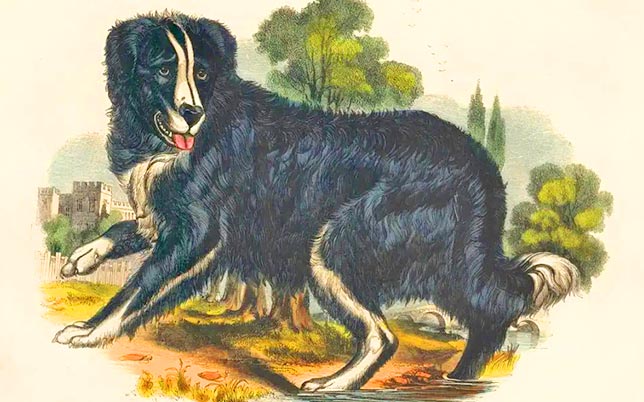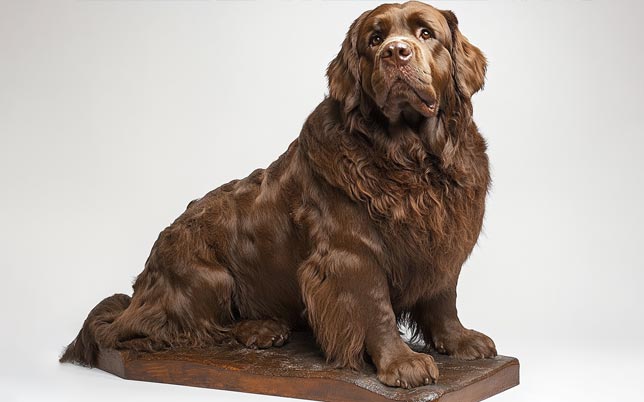Newfoundland -
Origin and history

Origin and history
The Newfoundland is an ancient and mysterious breed with a rich background of legends, sea tales and conflicting hypotheses. Due to the isolation of the island of Newfoundland and the lack of written sources, there is no absolute certainty about its exact origin. There are several main theories about the history of one of the most impressive and noble dog breeds, known for its strength, intelligence and good nature.
Origin and early history
The Newfoundland originated on the Canadian island of Newfoundland (now part of the province of Newfoundland and Labrador, Canada). The breed is believed to have developed in the 17th–18th centuries, as a result of the crossing of native dogs with European breeds brought by fishermen and settlers from England, Ireland, Portugal, and France. One of the most influential ancestors of the Newfoundland was the “great water dog” of the Beothuk Indians and early settlers—strong dogs accustomed to working in harsh conditions and cold waters. The typical “Newfoundland water dog” developed. They are mentioned in travelogues and fishing logs as working dogs with exceptional strength and swimming skills.
Another theory suggests that French Basques or Spanish fishermen brought powerful dogs—large water dogs or mastiff-like breeds such as the Pyrenean Shepherd Dog, Pyrenean Mountain Dog, and Pyrenean Mastiff—with them between 1506 and 1662. They were used for protection, work, and hauling gear during whaling and fishing expeditions. Crossbred with local animals, they created the basis of what is now Newfoundland.
A more exotic theory is that a Tibetan Mastiff (or some ancient Asian breed) was brought to Europe via Asia and later to the New World by European explorers and missionaries. Its genes (strong bone structure, thick coat) may have influenced the creation of the Newfoundland, but this remains a hypothesis without serious evidence.
Dogs were naturally selected – only the strongest, most resilient, and water-loving animals survived, capable of helping people in the icy waters of the North Atlantic.
St. John’s Dog (a city in Canada). While the distant ancestry of the Newfoundland dog is uncertain, there is consensus regarding the breed’s more recent ancestor, the St. John’s Water Dog. Now extinct, the St. John’s Water Dog was developed in Newfoundland and Labrador as a companion for fishermen. Varieties of the St. John’s Water Dog have been known as the Large Newfoundland, the Small Newfoundland, and the Small Labrador.
The St. John’s Water Dog is believed to have evolved from the crossbreeding of many dogs brought to Newfoundland by European fishermen. This crossbreeding dates back to John Cabot’s arrival on the shores of Newfoundland in 1497 and continued throughout the 16th and 17th centuries. The Pyrenean Mountain Dog, the Portuguese Water Dog, the Leonberger, and the Saint Bernard are some of the dog breeds that may have contributed to the genetic makeup of the St. John’s Water Dog and, subsequently, the Newfoundland dog of today.
An older, but more romantic, version holds that Newfoundlands are descendants of dogs brought by the Vikings around 1000 AD, when Leif Erikson and other Norsemen reached the east coast of Canada (Vinland). It is believed that their dogs were massive, similar to Norwegian hunting or herding dogs, which were accustomed to the cold and harsh environment, and are possible ancestors of other Nordic breeds such as the Icelandic Sheepdog.
Although the evidence is scarce, this version is supported by archaeological finds and Viking sagas, which mention “big dogs” in the new lands.
Their role in the fishing industry
In the 18th and 19th centuries, Newfoundlands were indispensable assistants to fishermen, because thanks to their powerful bodies and excellent swimming skills, they pulled nets out of the water, carried ropes between boats, rescued people who had fallen overboard, and swam long distances, even in icy waters.
Thanks to their large, webbed feet, thick, waterproof fur, and strong bodies, they were ideally suited to performing tasks in the water.
The truth probably lies in a combination of all these factors: isolation, harsh environment, the need for a healthy working dog, and selection from different gene pools. The result is a unique breed – a northern giant with a heart of gold, created not only by canine genes, but also by the spirit of the ocean, the cold, and human trust in a four-legged companion.
Popularity in Europe
In the 17th and 18th centuries, English settlers on the island of Newfoundland were impressed by the large size and strength of the native dogs, their natural swimming ability, and their gentle disposition. Traders brought the dogs back to England, where they were bred. Thus the North American Newfoundland evolved gradually, first through natural selection and later through selective breeding in Great Britain. The breed was first named around 1775.
The breed began to gain popularity in Europe during the late 18th and early 19th centuries, especially in England, where the British aristocracy embraced it with enthusiasm. The famous poet Lord Byron dedicated a poem to his Newfoundland named Botswain, and a statue of his dog stands on his grave.
In the 1800s, the breed began to be standardized in England. Two main types were created:
- A heavy and massive type (more popular today);
- A lighter and working type, used for a longer time in Canada
Newfoundland in the history of rescue
The dogs are known for their numerous heroic rescues:
Many of them have saved dozens of people from drowning; In France and Italy, Newfoundlands are still used by coastal rescue services; A Newfoundland named Seaman accompanied Lewis and Clark during their expedition across America (1804–1806).
Development as a show and domestic breed
In the 19th and 20th centuries, Newfoundlands were stars of dog shows and beloved family dogs. Recognized by the Kennel Club in England in 1886, and later by the American Kennel Club (AKC), the breed gained international popularity.
Date of acceptance on a definitive basis by the FCI 04.08.1954.
Today, the Newfoundland is bred primarily as a family pet, water rescue dog, and show dog. Highly respected for its good-behaviour nature and impressive appearance.
Today, the Newfoundland is known for being:
- Incredibly good-natured and gentle, especially with children (sometimes called the “gentle giant” and “nanny dog”);
- A strong swimmer and worker who loves the water;
- Quiet, even-tempered and intelligent – easily trainable;
- An excellent companion for both families and active people.
Interesting facts
– The Newfoundland is one of the five native breeds of Canada;
– The Newfoundland is one of the few breeds with webbed feet;
– They have a rescue instinct – they will often try to “rescue” people who are just swimming;
– Newfoundland Dog Day is March 25;
– The breed has a kind of “double coat” – a waterproof top coat and a fluffy undercoat;
– They appear in literature, cinema and art (e.g. Nana from “Peter Pan”).



